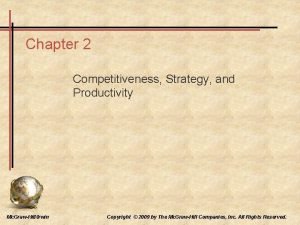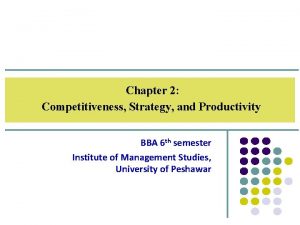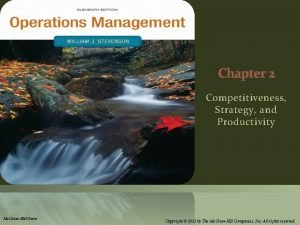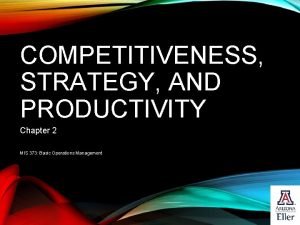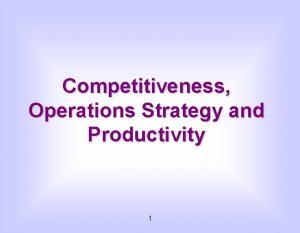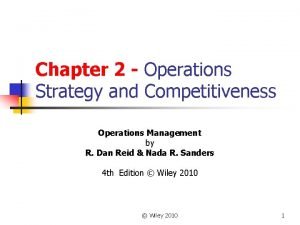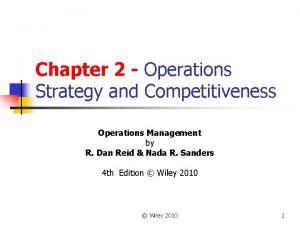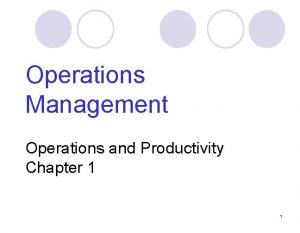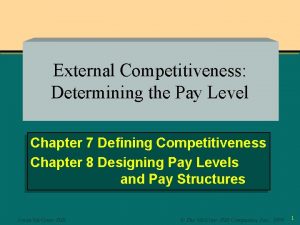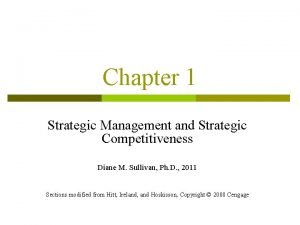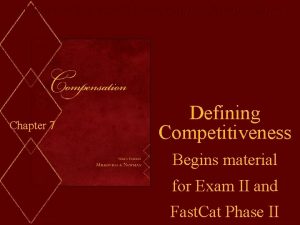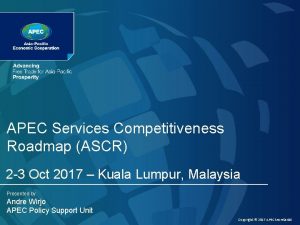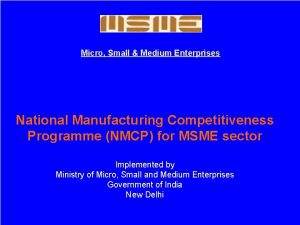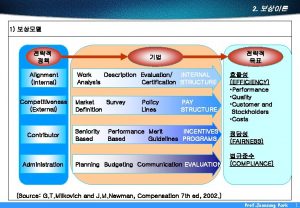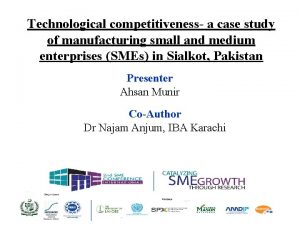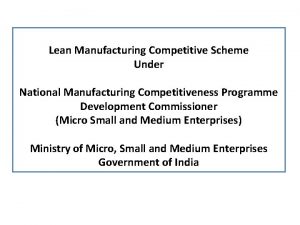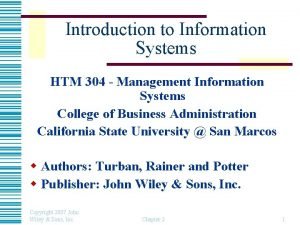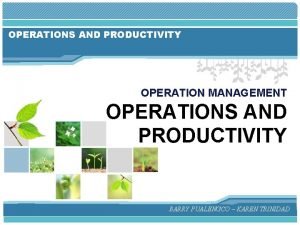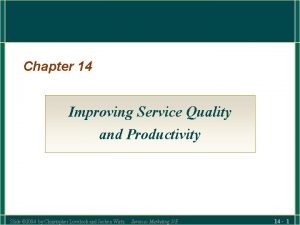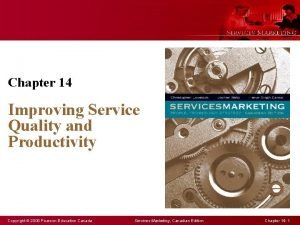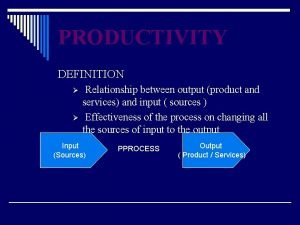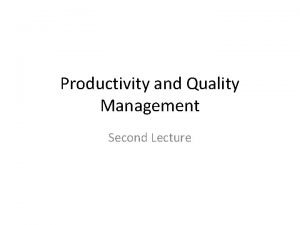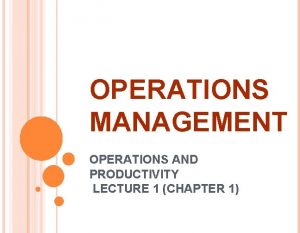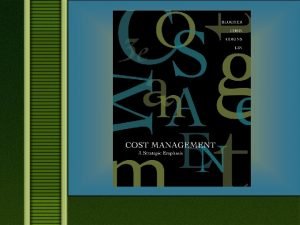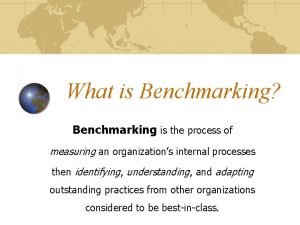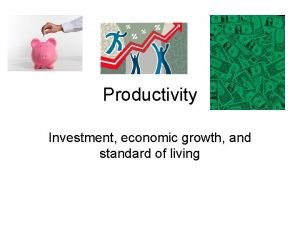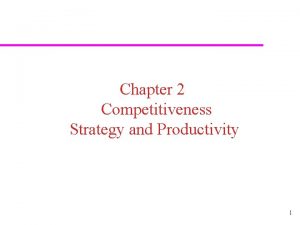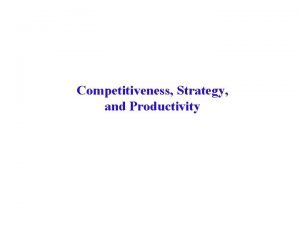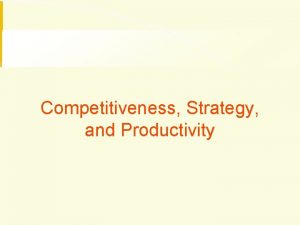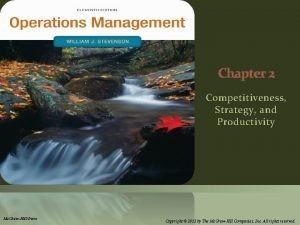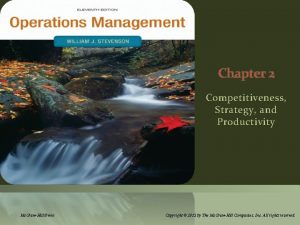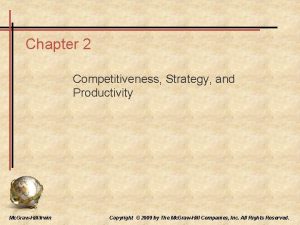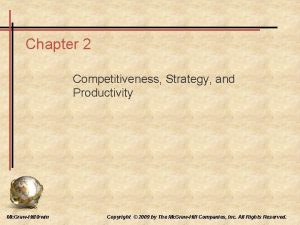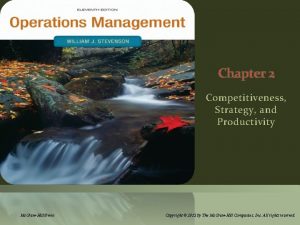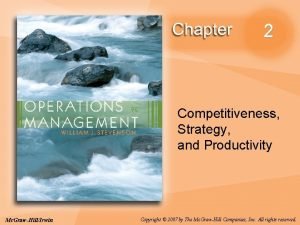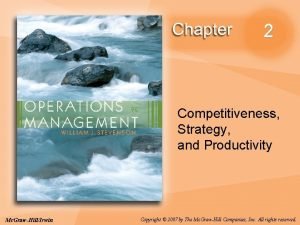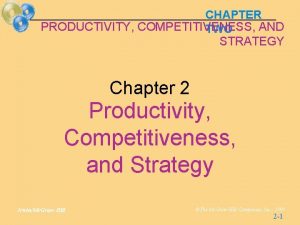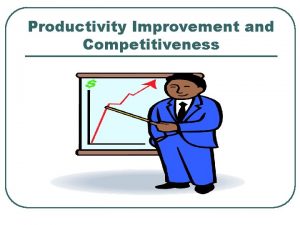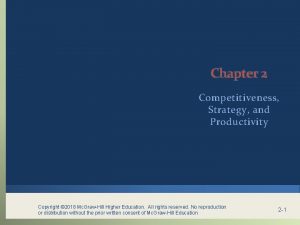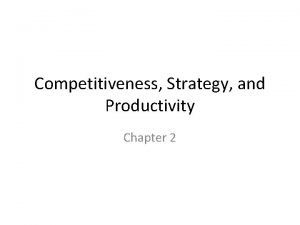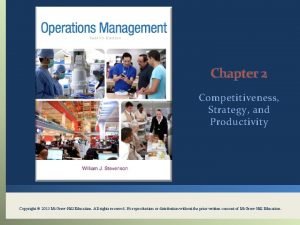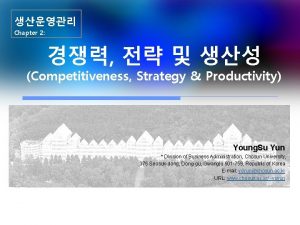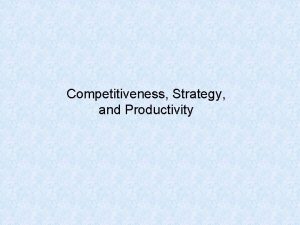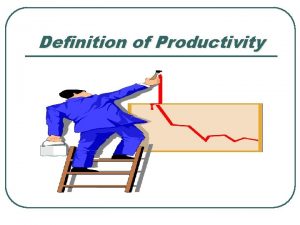Chapter 2 Competitiveness Strategy and Productivity Mc GrawHillIrwin






































- Slides: 38

Chapter 2 Competitiveness, Strategy, and Productivity Mc. Graw-Hill/Irwin Copyright © 2012 by The Mc. Graw-Hill Companies, Inc. All rights reserved.

Chapter Focus This chapter focuses on three separate, but related that are vitally important to business organizations § Competitiveness § Strategy § Productivity 2 -2

Competitiveness q How effectively an organization meets the wants and needs of customers relative to others that offer similar goods or services q Organizations compete through some combination of their marketing and operations functions 2 -3

Marketing’s Influence on Competitiveness Identifying consumer wants and/or needs The ideal is to achieve a perfect match between consumer wants and needs and the organization’s goods and/or services Pricing and quality It is important to understand the trade-off decision consumers make between price and quality Advertising and promotion Theses are ways organizations can inform potential customers about features of their products or services, and attract buyers 2 -4

Operations' Influence on Competitiveness Product and service design 2. Cost 3. Location 4. Quality 5. Quick response 6. Flexibility 7. Inventory management 8. Supply chain management 9. Service 10. Managers and workers 1. 2 -5

Why Some Organizations Fail 1. 2. 3. 4. 5. 6. 7. Neglecting operations strategy Failing to take advantage of strengths and opportunities and/or failing to recognize competitive threats Too much emphasis on short-term financial performance at the expense of R&D Too much emphasis in product and service design and not enough on process design and improvement Neglecting investments in capital and human resources Failing to establish good internal communications and cooperation Failing to consider customer wants and needs 2 -6

Hierarchical Planning Mission Goals Organizational Strategies Functional Strategies Tactics 2 -7

Planning and Decision Making Figure 2. 1 Mission Goals Organizational Strategies Functional Goals Finance Strategies Tactics Operating procedures Marketing Strategies Tactics Operating procedures Operations Strategies Tactics Operating procedures

Mission The reason for an organization’s existence Mission statement States the purpose of the organization The mission statement should answer the question of “What business are we in? ” "To promote child health and development through a comprehensive family and community initiative. " 2 -9

Goals The mission statement serves as the basis for organizational goals Goals Provide detail and the scope of the mission Goals can be viewed as organizational destinations Goals serve as the basis for organizational strategies 2 -10

Goals (examples_ By December 2010, to increase by 30% parent engagement (i. e. , talking, playing, reading) with children under 2 years of age. By 2012, to have made a 40% increase in youth graduating from high school. By the year 2006, increase by 30% the percentage of families that own their home. By December of this year, implement the volunteer training program for all volunteers. 11

Strategies Strategy A plan for achieving organizational goals Serves as a roadmap for reaching the organizational destinations Organizations have Organizational strategies Overall strategies that relate to the entire organization Support the achievement of organizational goals and mission Functional level strategies Strategies that relate to each of the functional areas and that support achievement of the organizational strategy use social marketing to promote adult involvement with children enhance the artistic life of the community by encouraging artists to perform in the area 2 -12

Tactics and Operations Tactics The methods and actions taken to accomplish strategies The “how to” part of the process Operations The actual “doing” part of the process Draft a social marketing plan Ask local corporations to introduce flex-time for parents and mentors 2 -13

Core Competencies �Core Competencies The special attributes or abilities that give an organization a competitive edge � To be effective core competencies and strategies need to be aligned 2 -14

Sample Operations Strategies Organizational Strategy Operations Strategy Examples of Companies or Services Low Price Low Cost U. S. first-class postage Wal-Mart Responsiveness Short processing times Mc. Donald’s restaurants On-time delivery Fed. Ex High performance design and/or high quality processing Sony TV Consistent Quality Coca-Cola Differentiation: Newness Innovation 3 M, Apple Differentiation: Variety Flexibility Burger King (Have it your way”) Volume Mc. Donald’s (“Buses Welcome”) Differentiation: Service Superior customer service Disneyland Differentiation: Location Convenience Differentiation: High Quality IBM Supermarkets; Mall Stores 2 -15

Strategy Formulation �Effective strategy formulation requires taking into account: � Core competencies � Environmental scanning �SWOT �Successful strategy formulation also requires taking into account: � Order qualifiers � Order winners 2 -16

Strategy Formulation Order qualifiers Characteristics that customers perceive as minimum standards of acceptability for a product or service to be considered as a potential for purchase Order winners Characteristics of an organization’s goods or services that cause it to be perceived as better than the competition 2 -17

Environmental Scanning is necessary to identify Internal Factors Strengths and Weaknesses External Factors Opportunities and Threats 2 -18

Key External Factors 1. 2. 3. 4. 5. 6. Economic conditions Political conditions Legal environment Technology Competition Markets 2 -19

Key Internal Factors 1. 2. 3. 4. 5. 6. 7. 8. Human Resources Facilities and equipment Financial resources Customers Products and services Technology Suppliers Other 2 -20

Operations Strategy Operations strategy The approach, consistent with organization strategy, that is used to guide the operations function. Decision Area What the Decisions Affect Product and service design Costs, quality, liability, and environmental issues Capacity Cost, structure, flexibility Process selection and layout Costs, flexibility, skill level needed, capacity Work design Quality of work life, employee safety, productivity Location Costs, visibility Quality Ability to meet or exceed customer expectations Inventory Costs, shortages Maintenance Costs, equipment reliability, productivity Scheduling Flexibility, efficiency Supply chains Costs, quality, agility, shortages, vendor relations Projects Costs, new products, services, or operating systems 2 -21

Quality-Based Strategies Quality-based strategy Strategy that focuses on quality in all phases of an organization Pursuit of such a strategy is rooted in a number of factors: Trying to overcome a poor quality reputation Desire to maintain a quality image A desire to catch up with the competition A part of a cost reduction strategy Instructor Slides 2 -22

Time-Based Strategies Time-based strategies Strategies that focus on the reduction of time needed to accomplish tasks It is believed that by reducing time, costs are lower, quality is higher, productivity is higher, time-to-market is faster, and customer service is improved Instructor Slides 2 -23

Time-Based Strategies Areas where organizations have achieved time reductions: Planning time Product/service design time Processing time Changeover time Delivery time Response time for complaints Instructor Slides 2 -24

Agile Operations Agile operations A strategic approach for competitive advantage that emphasizes the use of flexibility to adapt and prosper in an environment of change Involves the blending of several core competencies: Cost Quality Reliability Flexibility Instructor Slides 2 -25

Productivity A measure of the effective use of resources, usually expressed as the ratio of output to input Productivity measures are useful for Tracking an operating unit’s performance over time Judging the performance of an entire industry or country Instructor Slides 2 -26

Why Productivity Matters High productivity is linked to higher standards of living As an economy replaces manufacturing jobs with lower productivity service jobs, it is more difficult to maintain high standards of living Higher productivity relative to the competition leads to competitive advantage in the marketplace Pricing and profit effects For an industry, high relative productivity makes it less likely it will be supplanted by foreign industry Instructor Slides 2 -27

Productivity Measures Instructor Slides 2 -28

Example 1 10, 000 Units Produced Sold for $10/unit 500 labor hours Labor rate: $9/hr What is the labor productivity? Cost of raw material: $5, 000 Cost of purchased material: $25, 000

Example 1 --Labor Productivity 10, 000 units/500 hrs = 20 units/hour or we can arrive at a unitless figure (10, 000 unit* $10/unit)/(500 hrs* $9/hr) = 22. 22 Can you think of any advantages or disadvantages of each approach?

Example 2 7040 Units Produced Cost of labor of $1, 000 Cost of materials: $520 Cost of overhead: $2000 What is the multifactor productivity? Ans. 2. 0 units per dollar of input

Example 2 Solution MFP = Output Labor + Materials + Overhead MFP = (7040 units) $1000 + $520 + $2000 MFP = 2. 0 units per dollar of input

Productivity Calculation Example Units produced: Standard price: Labor input: Cost of labor: Cost of materials: Cost of overhead: 5, 000 $30/unit 500 hours $25/hour $5, 000 2 x labor cost What is the multifactor productivity? Instructor Slides 2 -33

Solution What is the implication of an unitless measure of productivity? Instructor Slides 2 -34

Productivity Growth Example: Labor productivity on the ABC assembly line was 25 units per hour in 2009. In 2010, labor productivity was 23 units per hour. What was the productivity growth from 2009 to 2010? Instructor Slides 2 -35

Service Sector Productivity � Service sector productivity is difficult to measure and manage because � It involves intellectual activities � It has a high degree of variability � A useful measure related to productivity is process yield � Where products are involved � ratio of output of good product to the quantity of raw material input. � Where services are involved, process yield measurement is often dependent on the particular process: � ratio of cars rented to cars available for a given day � ratio of student acceptances to the total number of students approved for admission. Instructor Slides 2 -36

Factors Affecting Productivity Methods Capital Technology Instructor Slides Quality Management 2 -37

Improving Productivity 1. Develop productivity measures for all operations 2. Determine critical (bottleneck) operations 3. Develop methods for productivity improvements 4. Establish reasonable goals 5. Make it clear that management supports and encourages productivity improvement 6. Measure and publicize improvements Don’t confuse productivity with efficiency Instructor Slides 2 -38
 The methods and actions taken to accomplish strategies
The methods and actions taken to accomplish strategies Competitiveness, strategy and productivity
Competitiveness, strategy and productivity Competitiveness strategy and productivity
Competitiveness strategy and productivity Competitiveness strategy and productivity
Competitiveness strategy and productivity Operations strategy and competitiveness
Operations strategy and competitiveness Productivity and competitiveness in operations management
Productivity and competitiveness in operations management Operations strategy and competitiveness
Operations strategy and competitiveness Operation management chapter 2
Operation management chapter 2 Operations strategy and competitiveness
Operations strategy and competitiveness Industrial organization model of above average returns
Industrial organization model of above average returns Operations and productivity chapter 1
Operations and productivity chapter 1 What is external competitiveness
What is external competitiveness Strategic competitiveness
Strategic competitiveness What shapes external competitiveness
What shapes external competitiveness Apec services competitiveness roadmap
Apec services competitiveness roadmap National manufacturing competitiveness programme
National manufacturing competitiveness programme Internal competitiveness
Internal competitiveness Technological competitiveness
Technological competitiveness Lean manufacturing competitiveness scheme
Lean manufacturing competitiveness scheme The best-known framework for analyzing competitiveness is
The best-known framework for analyzing competitiveness is Strategic competitiveness
Strategic competitiveness Defining competitiveness
Defining competitiveness Corporate strategy and business strategy
Corporate strategy and business strategy Chase strategy example
Chase strategy example Productivity operations management
Productivity operations management Improving service quality and productivity
Improving service quality and productivity Service quality and productivity
Service quality and productivity Safety quality and productivity
Safety quality and productivity Output/product
Output/product What is productivity
What is productivity Operations and productivity
Operations and productivity Nutrition and productivity
Nutrition and productivity Fixed reference linguistics
Fixed reference linguistics Strategic profitability analysis
Strategic profitability analysis Benchmarking example
Benchmarking example Productivity and standard of living
Productivity and standard of living Lam employment absence and productivity scale
Lam employment absence and productivity scale Home replication strategy example
Home replication strategy example Global operations strategy options
Global operations strategy options
